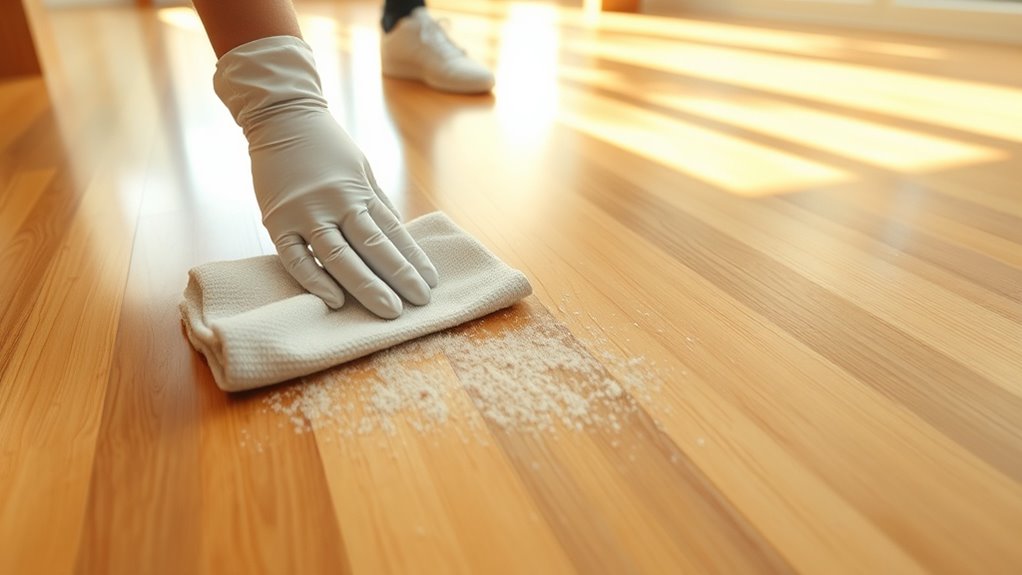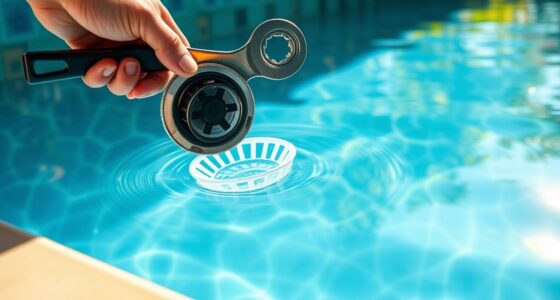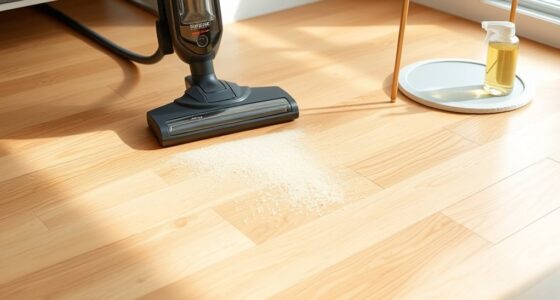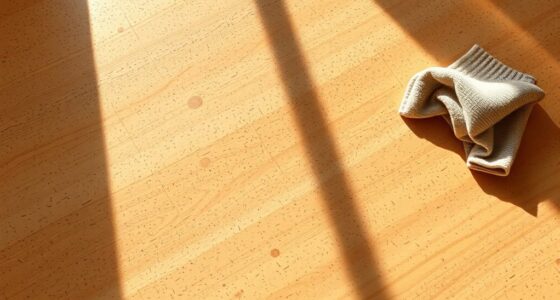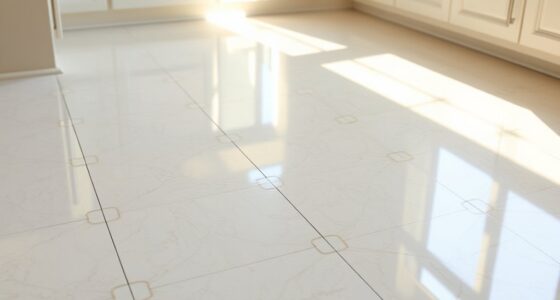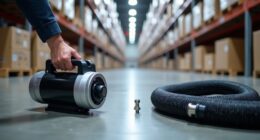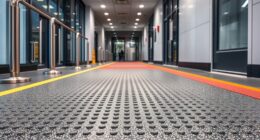To keep your bamboo floors allergy-safe, regularly vacuum with a HEPA-filtered cleaner, focusing on edges and under furniture. Use an air purifier to trap airborne dust and allergens in the room. Maintain your vacuum filters and empty dustbins often, and incorporate these practices into your weekly cleaning routine. This consistent approach helps reduce dust buildup, improves air quality, and keeps your floors healthy. If you want to discover more tips for effective dust control, keep exploring this guide.
Key Takeaways
- Use a HEPA-filter air purifier in rooms with bamboo floors to trap airborne allergens and dust particles.
- Regularly vacuum with a model designed for hard floors, focusing on edges and under furniture.
- Maintain vacuum filters by cleaning or replacing them every few months to ensure optimal dust collection.
- Incorporate weekly vacuuming and air purification into your routine for consistent dust and allergen control.
- Keep floors clean and dust-free to reduce allergy symptoms and protect the bamboo’s appearance and longevity.
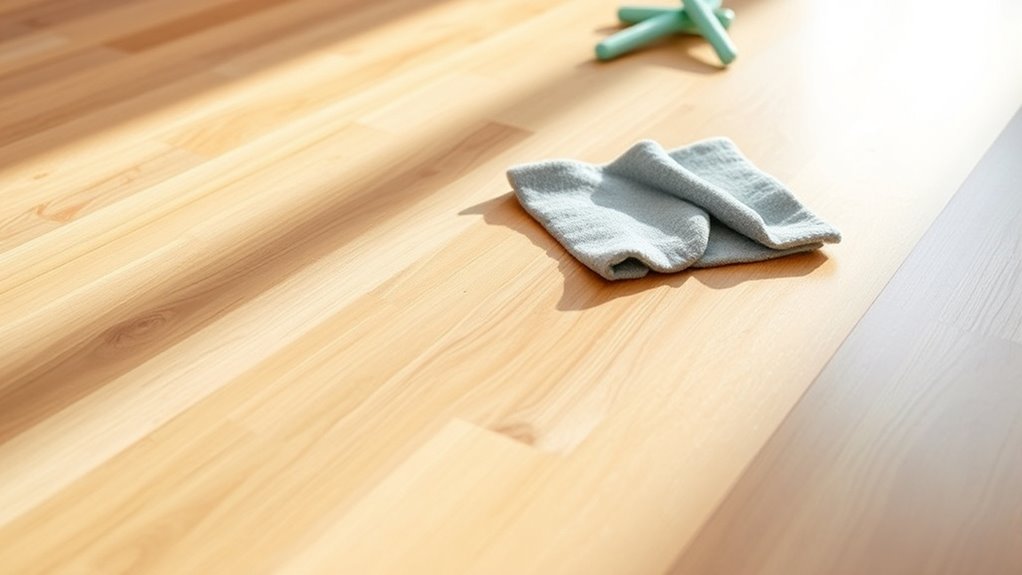
Are you struggling to keep dust off your bamboo floors? If so, you’re not alone. Bamboo floors are beautiful and durable, but they can easily attract dust, allergens, and debris that can settle into the grain or become airborne. To maintain a clean, allergy-safe environment, you need a routine that effectively tackles dust and keeps it from accumulating. One of the first steps is investing in air purifiers. These devices help trap airborne dust particles, pet dander, and other allergens before they settle on your floors or get inhaled. Place an air purifier in rooms where you spend the most time or where dust tends to settle the most. Make sure to choose a model with a HEPA filter, as it captures tiny particles that traditional filters might miss, providing cleaner air and reducing allergy symptoms over time.
In addition to air purifiers, regular vacuum maintenance is essential. Not all vacuums are created equal, especially when it comes to cleaning bamboo floors. Opt for a vacuum with a soft brush or a setting specifically designed for hard floors to prevent scratching the surface while efficiently picking up dust and debris. Make vacuuming part of your weekly cleaning routine, and don’t forget to check and replace the filters regularly. A clogged or dirty filter can diminish the vacuum’s effectiveness and release dust back into your home’s air. When you vacuum, pay special attention to edges, corners, and underneath furniture, where dust tends to gather. Using a vacuum with strong suction and a HEPA filter ensures that dust is captured and doesn’t get blown back into the room.
Maintaining your vacuum is just as important as using it. Empty the dustbin or replace the bag frequently to prevent dust from becoming airborne during cleaning. Clean the vacuum’s filters according to the manufacturer’s instructions, usually every few months, to keep it functioning at peak efficiency. Regular filter replacement and filter maintenance are crucial for optimal performance. Taking these steps will not only improve the cleanliness of your bamboo floors but also enhance the overall air quality in your home. Combining the use of air purifiers with diligent vacuum maintenance creates a synergy that greatly reduces dust accumulation and allergen presence. This routine helps you enjoy your bamboo floors without constantly battling dust or worry about allergy flare-ups. Staying consistent with these habits will make your space healthier and more comfortable, ensuring that your beautiful bamboo floors remain a source of pride and joy rather than a dust magnet.
Frequently Asked Questions
Can I Use Wet Mops on Bamboo Floors Without Damaging Them?
Yes, you can use wet mops on bamboo floors without causing bamboo damage if you do it carefully. Use a damp, not soaking wet, mop to avoid excess water that can seep into seams and cause warping or swelling. make certain you wring out the mop thoroughly before cleaning. Regularly wiping with a damp mop helps maintain cleanliness while protecting your bamboo floors from potential damage.
How Often Should I Deep Clean Bamboo Floors for Allergy Safety?
A stitch in time saves nine, so you should deep clean your bamboo floors every 1-2 months to maintain allergy-safe routines. Regular deep cleaning removes dust, pet dander, and allergens that can accumulate and trigger allergies. Use gentle, bamboo-safe cleaning solutions, and avoid harsh chemicals. Consistent cleaning keeps your floors pristine and your indoor air quality high, ensuring a healthier environment for everyone.
Are There Specific Vacuum Types Best for Dust Control on Bamboo?
You should choose a vacuum with a HEPA filter to maximize dust control on bamboo floors. Regular vacuum maintenance guarantees the filter remains effective, preventing dust from recirculating. Opt for a lightweight, upright or canister model with strong suction and good maneuverability. Check that the filter seals properly and replace it as recommended. This routine helps keep dust and allergens at bay, creating a safer environment for allergy sufferers.
What Natural Remedies Help Reduce Dust on Bamboo Flooring?
Think of your bamboo floor as a garden needing gentle care. Natural dust repellents like lemon juice and vinegar work as plant-based remedies to keep dust at bay. Spray a mixture of water with a few drops of lemon or vinegar onto your floor regularly, then wipe with a soft cloth. These remedies help reduce dust naturally, keeping your bamboo floor cleaner and allergy-safe without harsh chemicals.
Do Air Purifiers Improve Dust Control on Bamboo Floors?
Yes, air purifiers improve dust control on bamboo floors by effectively removing dust particles from the air. Their effectiveness depends on the filter quality, with HEPA filters being the best for capturing tiny particles. You should choose an air purifier suited to your room size and run it regularly to keep dust levels low. This helps create a cleaner, allergy-safe environment and reduces dust buildup on your bamboo floors.
Conclusion
By following these simple dust control tips, you can create a more inviting and comfortable space on your bamboo floors. A little regular effort goes a long way in maintaining a fresh, allergy-safe environment that feels as cozy as a gentle breeze. Embrace these easy routines, and you’ll enjoy the beauty of your floors without the worry of pesky dust settling in. After all, a little care makes your home a true sanctuary of comfort and cleanliness.
